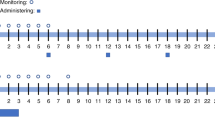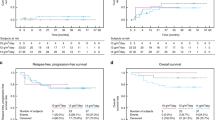Summary:
The pharmacokinetics of two etoposide (E) formulations were evaluated in patients with refractory hematologic malignancies receiving high-dose conditioning with autologous stem cell transplantation. Patients were randomized to either E at 800 mg/m2 (containing polysorbate 80 and polyethylene glycol) or etoposide phosphate (EP) at 910 mg/m2 on days −7 and −5, prior to melphalan, 80 mg/m2 on day −5. On day −3, EP was repeated. Plasma E was analyzed after each formulation on days −7 and −5 to compare intrapatient pharmacokinetics. In total, 10 patients were treated: four each with multiple myeloma or Hodgkin's disease and two with non-Hodgkin's lymphoma. Mucositis was the major toxicity with seven patients. EP first produced grade 3 mucositis. There was no procedure-related mortality and eight patients remained alive 1 year post-transplant. Cumulative etoposide exposure (AUC) was slightly greater with EP (P=0.056). Conversely, the volume of distribution was slightly, 33%, larger (P=0.052) and clearance was increased with the E infusion (P=0.14). As none of the differences reached statistical significance, both E formulations appear to be pharmacokinetically equivalent in the high-dose transplant setting. The combination of high-dose EP with melphalan is an active preparative regimen prior to ABMT for hematologic malignancies.
This is a preview of subscription content, access via your institution
Access options
Subscribe to this journal
Receive 12 print issues and online access
$259.00 per year
only $21.58 per issue
Buy this article
- Purchase on Springer Link
- Instant access to full article PDF
Prices may be subject to local taxes which are calculated during checkout

Similar content being viewed by others
References
Crump M, Smith AM, Brandwein J et al. High-dose etoposide and melphalan, and autologous bone marrow transplantation for patients with advanced Hodgkin's disease: importance of disease status at transplant. J Clin Oncol 1993; 11: 704–711.
Jackson GH, Lennard AL, Taylor PR et al. Autologous bone marrow transplantation in poor-risk high-grade non-Hodgkin's lymphoma in first complete remission. Newcastle and Northern Lymphoma Group. Br J Cancer 1994; 70: 501–505.
Seymour LK, Dansey RD, Bezwoda WR . Single high-dose etoposide and melphalan with non-cryopreserved autologous marrow rescue as a primary therapy for relapsed, refractory and poor-prognosis Hodgkin's disease. Br J Cancer 1994; 70: 526–530.
Taylor PR, Jackson GH, Lennard AL et al. Autologous transplantation in poor risk Hodgkin's disease using high dose melphalan/etoposide conditioning with non-cryopreserved marrow rescue. The Newcastle and Northern Region Lymphoma Group. Br J Cancer 1993; 67: 383–387.
van Besien K, Demuynck H, Lemaistre CF et al. High-dose melphalan allows durable engraftment of allogeneic bone marrow. Bone Marrow Tansplant 1995; 15: 321–323.
Vesole DH, Jagannath S, Glenn L et al. Autotransplantation in multiple myeloma. Haem Oncol Clin NA 1993; 7: 613–630.
Young RR, Zamkoff KW, Maness L et al. Comparison of etopophos, cytoxan and thiotepa as conditioning regimens for autologous peripheral blood stem cell transplantation in patients with high risk NH:L. Proc Am Assoc Clin Oncol 1996; 15: 335.
Topolsky D, Biggs . Transplantation in multiple myeloma. Semin Oncol 1995; 23: 230–237.
Gianni AM, Bregni M, Sienaet et al. Granulocyte–macrophage colony-stimulating factor or granulocyte colony-stimulating factor infusion makes high-dose etoposide a safe outpatient regimen that is effective in lymphoma and myeloma patients. J Clin Oncol 1992; 10: 1955–1962.
Lilley ER, Rosenberg MC, Elion GB et al. Synergistic interactions between cyclophosphamide or melphalan and VP-16 in a human rhabdomyosarcoma xenograft. Cancer Res 1990; 50: 284–287.
Nishikawa K, Kusama K, Ekimoto H, Takahashi K . Combination effects of etoposide with other antitumor drugs in vitro and in vivo. Gan To Kagaku Ryoho 1989; 16: 3739–3745.
Masini E, Planchenault J, Pezziardi F et al. Histamine-releasing properties of Polysorbate 80 in vitro and in vivo: correlation with its hypotensive action in the dog. Agents Actions 1985; 16: 470–477.
Dorr RT, Von Hoff DD . Cancer Chemotherapy Handbook, 2nd edn, Appleton & Lange, Norwalk, Conn., USA, 1994, pp. 459–472.
Varma RK, Kaushal R, Junnarkar AY et al. Polysorbate 80: a pharmacological study. Drug Res 1985; 35: Nr.5.
Harrison SD, Cusic AM, McAfee SM . Tween 80 increases plasma adriamycin concentrations in mice by an apparent reduction of plasma volume. Eur J Cancer 1981; 17: 387–389.
Cummings J, Forrest GJ, Cunningham D et al. Influence of polysorbate 80 (Tween 80) and etoposide (VP-16-213) on the pharmacokinetics and urinary excretion of adriamycin and its metabolites in cancer patients. Cancer Chemother Pharmacol 1986; 17: 80–88.
Azmin MN, Stuart JFB, Florence AT . The distribution and elimination of methotrexate in mouse blood and brain after concurrent administration of polysorbate 80. Cancer Chemother Pharmacol 1985; 14: 238–242.
Schinghammer TL, Reilly M . Cracking of ABS plastic devices using undiluted etoposide injection. Am J Hosp Pharm 1988; 45: 1277.
Lazarus HM, Creger RJ, Diaz D . Simple method for the administration of high-dose etoposide during autologous bone marrow transplantation. Cancer Treat Rep 1985; 70: 819–820.
Creger RJ, Fox RM, Lazarus HM . Infusion of high doses of undiluted etoposide through central venous catheters during preparation for bone marrow transplantation. Cancer Invest 1990; 8: 13–16.
Schacter LP, Igwemezie LN, Seyedsadr M et al. Clinical and pharamcokinetic overview of parenteral etoposide phosphate. Cancer Chemother Pharmacol 1994; 34: S58–S63.
Budman DR, Igwemezie LN, Kaul S et al. Phase I evaluation of a water-soluble etoposide prodrug, etoposide phosphate, given as a 5-minute infusion on Days 1, 3 and 5 in patients with solid tumors. J Clin Onc 1994; 12: 1902–1909.
Kaul S, Igwemezie LN, Stewart DJ et al. Pharmacokinetics and bioequivalence of etoposide following intravenous administration of etoposide phosphate and etoposide in patients with solid tumors. J Clin Onc 1995; 13: 2935–2841.
Thompson DS, Greco A, Miller A et al. A phase I study of etoposide phosphate administered as a daily 30-minute infusion for 5 days. Clin Pharm Ther 1995; 57: 499–507.
Sessa C, Zucchetti M, Cerny T et al. Phase I clinical and pharmacokinetic study of oral etoposide phosphate. J Clin Oncol 1995; 13: 200–209.
Chabot GG, Armand J-P, Terret C et al. Etoposide bioavailability after oral administration of the prodrug etoposide phosphate in cancer patients during a phase I study. J Clin Oncol 1996; 14: 2020–2030.
Brooks DJ, Srinivas NR, Alberts DS et al. Phase I and pharmacokinetic study of etoposide phosphate. Anti-Cancer Drugs 1995; 6: 637–644.
Hande KR, Wedlund PJ, Noone RM et al. Pharmacokinetics of high-dose etoposide (VP-16-213) administered to cancer patients. Cancer Res 1984; 44: 379–382.
Cummingham D, Cummings J, Blackie RB et al. The pharmacokinetics of high dose cyclophosphamide and high dose etoposide. Medical Onc Tumor Pharmacother 1988; 5: 117–123.
Fields SZ, Budman DR, Young RR et al. Phase I study of high-dose etoposide phosphate in man. Bone Marrow Transplant 1996; 18: 851–856.
Kreis W, Budman DR, Vinciguerra V et al. Pharmacokinetic evaluation of high-dose etoposide phosphate after a 2-hour infusion in patients with solid tumors. Can Chemother Pharmacol 1996; 38: 378–384.
Reif S, Kingreen D, Dloft C et al. Bioequivalence investigation of high-dose etoposide and etopoisde phosphate in lymphoma patients. Can Chemother Pharmacol 2001; 48: 134–140.
Bearman SI, Applebaum FR, Buckner SD et al. Regimen-related toxicity in patients undergoing bone marrow transplantation. J Clin Oncol 1988; 8: 1562–1568.
Gouyette A, Deniel A, Pico JL et al. Clinical pharmacology of high-dose etoposide associated with cisplatin. Pharmacokinetic and metabolic studies. Eur J Cancer Clin Onc 1987; 23: 1627–1632.
Ellis AG, Crinis NA, Webster LK . Inhibition of etoposide elimination in the isolated perfused rat liver by cremophor EL and Tween 80. Cancer Chemother Pharmacol 1996; 38: 81–87.
Tsujino I, Yamazaki T, Masutani M et al. Effect of tween-80 on cell killing by etoposide in human lung adenocarcinoma cells. Cancer Chemother Pharmacol 1999; 43: 29–34.
Chow H-H, Lalka D . The influence of vitamin K3 treatment of the pharmacokinetics and metabolism of (+)-propranolol in the rat. Drug Metab Dispos 1992; 20: 288–294.
Stewart CF, Arbuck SG, Fleming RA, Evans WE . Changes in the total and unbound etoposide in patients with liver dysfunction. J Clin Oncol 1990; 8: 1874–1879.
Briggs AD, Taylor CW, Sturm TJ et al. High-dose melphalan and etoposide prior to autologous hematopoietic stem cell transplant is an effective regimen in the treatment of multiple myeloma. Blood 1998; 92: p. 362b.
Acknowledgements
This study was supported in part by a grant from Bristol Myers Oncology Division, Plainsboro, NJ and by Grant CA-23074 from the National Cancer Institute, Bethesda, MD and supported in part by a grant from Bristol Myers Squibb, Oncology Section, Princeton, NJ USA (AB) and by Grants CA17094 (RTD), CA23078 (RTD) from National Cancer Institute, National Institutes of Health, Bethesda, MD USA.
Author information
Authors and Affiliations
Rights and permissions
About this article
Cite this article
Dorr, R., Briggs, A., Kintzel, P. et al. Comparative pharmacokinetic study of high-dose etoposide and etoposide phosphate in patients with lymphoid malignancy receiving autologous stem cell transplantation. Bone Marrow Transplant 31, 643–649 (2003). https://doi.org/10.1038/sj.bmt.1703906
Received:
Accepted:
Published:
Issue Date:
DOI: https://doi.org/10.1038/sj.bmt.1703906



